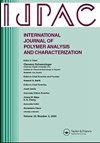椰壳纤维增强对聚氯乙烯复合材料的电阻研究
IF 1.7
4区 工程技术
Q4 POLYMER SCIENCE
International Journal of Polymer Analysis and Characterization
Pub Date : 2023-07-04
DOI:10.1080/1023666X.2023.2250616
引用次数: 0
摘要
当前的电力电子仪表如开关、电缆、变压器和良好的电气绝缘材料因其紧凑和环保的设计而受到人们的重视。一种具有良好电阻性的增塑型聚氯乙烯/椰壳纤维基聚合物复合材料可以满足这些要求。选择椰子纤维是因为它提供动力强度,并且比其他填料具有更少的流明。增塑型聚氯乙烯是用椰子纤维增强而成的一种绝缘聚合物复合材料。采用实验设计(DOE)方法,以2/4/6 wt创建各种样品。通过Box-Behnken设计,采用响应面法对纤维含量、75/150/225 μm纤维尺寸和三乙氧基(乙基)硅烷(1)/氢氧化钠(2)/氢氧化钾(3)进行化学处理。利用MINITAB统计软件进行方差分析(ANOVA),通过回归方程得到最优参数水平。此外,将实验结果与优化结果进行比较,进行误差分析。一个2wt的组合。%的coir纤维,208.33 μm的coir纤维和三乙氧基(乙基)硅烷处理得到的复合材料具有274.47千兆欧姆的高电阻,具有良好的绝缘效果。本文章由计算机程序翻译,如有差异,请以英文原文为准。
Investigation of electrical resistance on coir fiber reinforced P-polyvinyl chloride composites
Abstract Current power electronics instruments like switches, cables, transformers and good electrical insulating materials are gaining consideration for their compact and environmental design. A plasticized polyvinyl chloride/coir fiber-based polymer composite, displaying good electrical resistance, is suggested to meet these objectives. Coir fiber is chosen as it gives powered strength and has fewer lumens than other fillers. Plasticized polyvinyl chloride is strengthened using coir fiber to create a insulating polymer composites. The design of experiments (DOE) method is used to create various samples with 2/4/6 wt.% of fiber content, 75/150/225 μm of fiber size and triethoxy (ethyl) silane (1)/sodium hydroxide (2)/potassium hydroxide (3) of chemical treatments using the response surface methodology through Box–Behnken design. Further, analysis of variance (ANOVA) is carried out using MINITAB statistical software to achieve optimum parameter levels through the regression equation. Additionally, the comparison of experimental and optimized findings leads to error analysis. A combination of 2 wt.% of coir fiber, 208.33 μm of coir fiber size and Triethoxy(ethyl) silane Treatment produces a composite with high resistance of 274.47 Giga-ohms, which is significant for good insulating purpose.
求助全文
通过发布文献求助,成功后即可免费获取论文全文。
去求助
来源期刊
CiteScore
3.50
自引率
5.30%
发文量
37
审稿时长
1.6 months
期刊介绍:
The scope of the journal is to publish original contributions and reviews on studies, methodologies, instrumentation, and applications involving the analysis and characterization of polymers and polymeric-based materials, including synthetic polymers, blends, composites, fibers, coatings, supramolecular structures, polysaccharides, and biopolymers. The Journal will accept papers and review articles on the following topics and research areas involving fundamental and applied studies of polymer analysis and characterization:
Characterization and analysis of new and existing polymers and polymeric-based materials.
Design and evaluation of analytical instrumentation and physical testing equipment.
Determination of molecular weight, size, conformation, branching, cross-linking, chemical structure, and sequence distribution.
Using separation, spectroscopic, and scattering techniques.
Surface characterization of polymeric materials.
Measurement of solution and bulk properties and behavior of polymers.
Studies involving structure-property-processing relationships, and polymer aging.
Analysis of oligomeric materials.
Analysis of polymer additives and decomposition products.

 求助内容:
求助内容: 应助结果提醒方式:
应助结果提醒方式:


